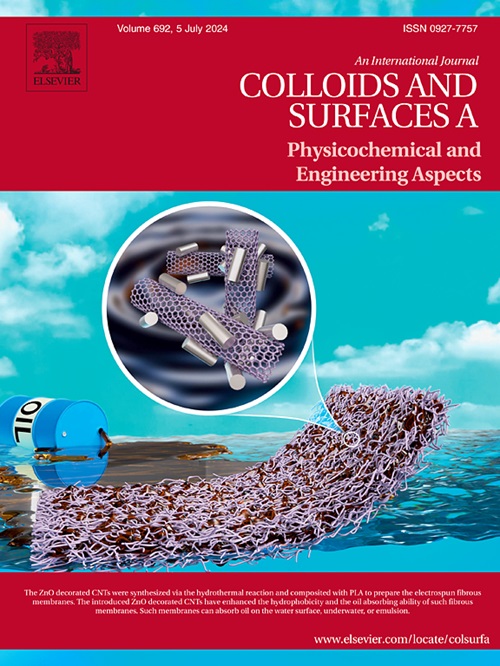无机阳离子对水溶液中气泡-油滴聚结的影响
IF 5.4
2区 化学
Q2 CHEMISTRY, PHYSICAL
Colloids and Surfaces A: Physicochemical and Engineering Aspects
Pub Date : 2025-07-17
DOI:10.1016/j.colsurfa.2025.137778
引用次数: 0
摘要
了解电解液中气泡与表面活性剂稳定油滴之间的相互作用对于控制膜稳定性和提高浮选效率至关重要。与研究充分的气泡聚结相比,由于表面活性剂的存在,气泡-液滴相互作用涉及不同的界面动力学。本研究将分子动力学模拟与宏观聚结实验相结合,研究了金属离子水化和试剂吸附对气泡-液滴聚结的影响,旨在阐明离子条件下界面动力学与内部气泡压力之间的耦合关系。研究表明,多价离子破坏了水的氢键网络,促进了2-辛醇在气液界面的吸附,改变了液膜表面张力。由此产生的表面张力梯度,结合流体粘度,控制着膜内的界面压力和动压力,最终决定了在聚并过程中内部气泡压力的变化。该研究结果为金属离子调控表面活性剂在气液界面的行为提供了分子水平的见解,为泡沫浮选性能的控制提供了理论依据。本文章由计算机程序翻译,如有差异,请以英文原文为准。
Effect of inorganic cations on bubble-oil droplet coalescence in aqueous solution
Understanding the interaction between bubbles and surfactant-stabilized oil droplets in electrolyte solutions is essential for controlling film stability and enhancing flotation efficiency. Compared to well-studied bubble coalescence, bubble-droplet interactions involve distinct interfacial dynamics due to the presence of surface-active agents. This study combined molecular dynamics simulations with macroscopic coalescence experiments to investigate the effects of metal ion hydration and reagent adsorption on bubble-droplet coalescence, aiming to elucidate the coupling between interfacial dynamics and internal bubble pressure under ionic conditions. Studies show that multivalent ions disrupt the hydrogen-bonding network of water, promoting 2-octanol adsorption at the gas-liquid interface and altering liquid film surface tension. The resulting surface tension gradients, combined with fluid viscosity, govern interfacial and dynamic pressures within the film, ultimately dictating internal bubble pressure changes during coalescence. The findings provide molecular-level insights into the regulation of surfactant behavior at gas-liquid interfaces by metal ions, offering a theoretical basis for the control of froth flotation performance.
求助全文
通过发布文献求助,成功后即可免费获取论文全文。
去求助
来源期刊
CiteScore
8.70
自引率
9.60%
发文量
2421
审稿时长
56 days
期刊介绍:
Colloids and Surfaces A: Physicochemical and Engineering Aspects is an international journal devoted to the science underlying applications of colloids and interfacial phenomena.
The journal aims at publishing high quality research papers featuring new materials or new insights into the role of colloid and interface science in (for example) food, energy, minerals processing, pharmaceuticals or the environment.

 求助内容:
求助内容: 应助结果提醒方式:
应助结果提醒方式:


